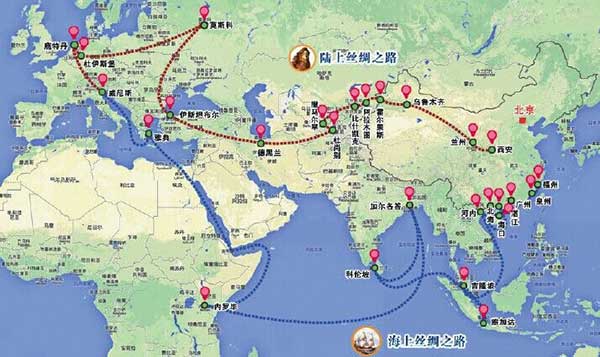

 |
| (File Photo) |
The 'Belt and Road Initiative' gets a major boost with Pakistan project, say experts
The Silk Road Fund's first overseas investment project is expected to demonstrate a new financing model that supports infrastructure construction and improves connectivity across the regions involved in the "Belt and Road Initiative", experts said on Tuesday.
The $40-billion Silk Road Fund, set up in December 2014, will inject capital in China Three Gorges South Asia Investment Ltd, a subsidiary of China Three Gorges Corp, to develop the Karot hydropower project on the Jhelum River in northeastern Pakistan.
The project will be funded through a mix of equity and loan investments, said a statement released on the website of the People's Bank of China, the central bank.
"The investment structure includes global investors and follows international standards, which means the project is feasible and can achieve mutual benefit and win-win results for partners," Jin Qi, chairwoman of the Silk Road Fund Co Ltd, told China Daily in an exclusive interview.
The infrastructure construction project, under the framework of the China-proposed Silk Road Economic Belt and the 21st Century Maritime Silk Road initiative, is expected to ease electricity shortage in Pakistan and support its economic development, said Jin.
"It also shows the fund's attitude of being open and inclusive," she said.
The fund will take a stake in a subsidiary of China Three Gorges Corp-the Three Gorges South Asia Investment Ltd, which is jointly developing the hydropower station with Pakistan's Private Power and Infrastructure Committee. It will also invest in other clean-energy projects in the South Asian region. The International Finance Corp, a member of the World Bank Group, is another shareholder in the Chinese construction company.
The Silk Road Fund has also joined a consortium comprising the Export-Import Bank of China, China Development Bank and the IFC to provide loans. But the fund has not yet disclosed further information about the ownership ratio or amount of the loan.
John Zhou, an economist at HSBC Holdings Plc, said that the fund's investment structure is a balance between both opportunities and risks under the "Belt and Road Initiative".
"In terms of the equity investment, investors' returns are more correlated with the performance of the projects, giving them every incentive to perform detailed due diligence," said Zhou. "For the recipient countries, direct equity investment is generally considered the most beneficial."
As for the loan, it needs to be serviced immediately and continuously, but the returns are more stable, he said. "But it is equity investment where the 'Belt and Road Initiative' will look to truly innovate by involving public and private investors, as well as international organizations-old and new."
"The fund could become a model of public-private cooperation", as the central bank Governor Zhou Xiaochuan has stressed that it will operate like a private equity fund but with a longer investment horizon, the HSBC economist said.
The launch of the fund's first project also means that China has started to diversify the investment of its foreign exchange reserves, said Zhang Xiaoji, a researcher at the State Council's Development Research Center.
Initial capital of the fund was $10 billion, with 65 percent coming from the nation's foreign exchange reserves.
"By using the foreign exchange reserves for equity and debt investment purposes, the fund will provide more opportunities for Chinese enterprises going overseas," he said.
The "Belt and Road Initiative" is expected to be a key part of China's economic and overseas development plans for years to come and financial platforms will be important for supporting construction projects in the countries involved, said Zhang Xiaoqiang, vice-chairman of the China Center for International Educational Exchange, a government think tank.
In addition, one of the major themes of the New Silk Road roadmap is the way it will integrate China's financial market with the rest of Asia, he said.
"The Silk Road Fund could develop cooperation with international financial institutions, such as the Asian Development Bank and the World Bank, as they have complementary advantages, to give financial support in the regions," said Zhang.
 J-11 fighters in air exercise
J-11 fighters in air exercise Beauties dancing on the rings
Beauties dancing on the rings Attendants-to-be join Mr. & Miss Campus Contest
Attendants-to-be join Mr. & Miss Campus Contest Beijing's toughest anti-smoking law takes effect
Beijing's toughest anti-smoking law takes effect Family lives in cave for about 50 years in SW China
Family lives in cave for about 50 years in SW China PLA soldiers operating vehicle-mounted guns in drill
PLA soldiers operating vehicle-mounted guns in drill Blind carpenter in E China's Jiangxi
Blind carpenter in E China's Jiangxi China hosts overseas disaster relief exercise for the first time
China hosts overseas disaster relief exercise for the first time 20 pairs of twins who will become flight attendants in Sichuan
20 pairs of twins who will become flight attendants in Sichuan Obama is sowing discontent in S.China Sea
Obama is sowing discontent in S.China Sea Rescuers work through night to reach cruise ship survivors
Rescuers work through night to reach cruise ship survivors Driving through limbo
Driving through limbo Facing down MERS
Facing down MERSDay|Week